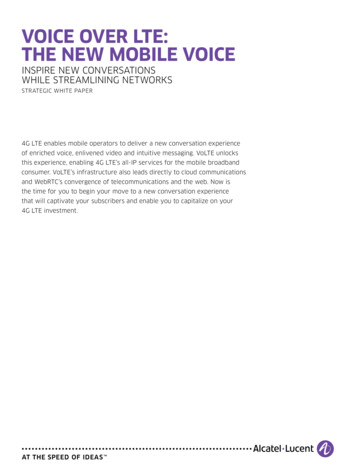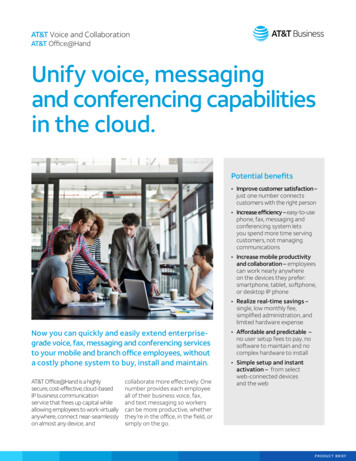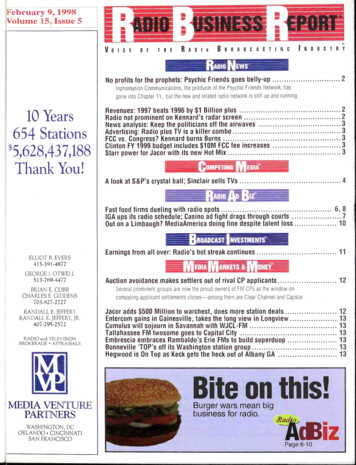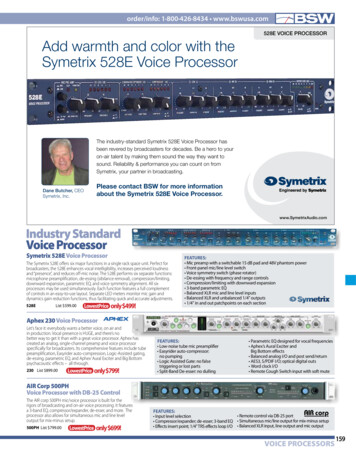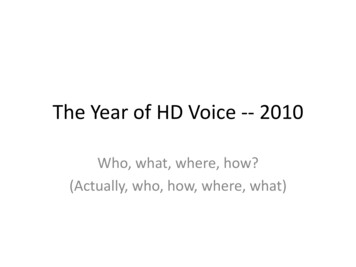
Transcription
The Year of HD Voice -- 2010Who, what, where, how?(Actually, who, how, where, what)
Doug Mohney - Background Following the ICT sector for over two decades Writing for Boardwatch, The Inquirer, VONMagazine (Pulvermedia), TMC Started HD voice coverage in May 2009 Launch of HD Voice News (HD Connect Now)in August 2009
The 2009 HD voice wake-up call France Telecom deployments– Broadband: Over 500,000 G.722 VoIP endpoints– Mobile: AMR-WB deployed in Moldova Global Crossing– Built HD conference bridge for customer– Working on open HD conferencing bridge Verizon Business– Close to 5,000 phones at HQ– Expects early adopters in 2010, general availability in 2011 Cablevision (Optimum Lightwave)– Deployed hosted HD voice service in 2H09
Yes Once again, the United States of America isbeing outclassed by the rest of the world intelecommunications technology .
Or U.S. carriers will wait until the smoke clearsand then get a deal because someone else hasdone the hard R&D
Who: Companies in HD voice“ecosystem” IP desktop handset manufacturers – ALL major– Aastra, AudioCodes, Avaya, Cisco, Polycom Mobile handset manufacturers– Nokia, Sony Ericsson declared, anyone with Android & 4G,others to come Network core– Aculab, Dialogic, D2 Technologies, Ericsson, TrinityConvergence Applications– BroadSoft, CommuniGate, Unisys, WYDEVoice Service Providers– Cablevision, France Telecom, 8x8, ooma, WorldGate
What is HD Voice? First- What is narrowband voice?– Acoustic standards set in 1937 Since ‘37, FM radio, TV, CD, HDTV, HD radio – PSTN grade call 3.4 kHz range– 300 Hz to 3400 Hz– G.711 is VoIP equivalent, 64 kbp/s bandwidth
What is HD voice? Also known as wideband voice Range of at least 7 kHz sampling; i.e. twice therange of G.711 G.722 codec is baseline HD voice:– 30 Hz to 7000 Hz– 2x PSTN/G.711– Still only need 64 kbit/s Other HD voice codecs include AMR-WB, SILK,GIPS iSAC.
HD - Looking at Hertz300002500020000150001000050000
Benefits from HD voice Reduction of fatigue– Narrowband clipping means brain plays “fill in theblanks” in the background– More data less brain strain– A reason why long conference calls suck! Better compensation and clarity– Similar-sounding words like "sail" and "fail"– Acronyms are “notorious” for garbling End up having to repeat and/or spell out
HD Voice is much more than a codec. Typically an all-IP application Requires capable speakers & microphones– PSTN can’t handle wideband– You can fake it on mobile network with the right gear– SIP for interoperability Need good QoS, low latency– If you can’t do vanilla VoIP On large scale, need agreements to interconnectvia SIP for seamless HD calling, transcodingbetween HD codecs
How do you get HD voice to talk to thePSTN? To other HD voice users? Different codec types – Transcoding– HD voice to PSTN/G.711/G.729– G.722 to AMR-WB, SILK, iSAC Same codec type– On same LAN– Interconnection via SIP
HD voice and the island problem Service providers don’t do SIPpeering/interconnect/federations out of the box––––Security considerations (SPIT, DDoS, you name it)ENUM is overheadQuality of ServiceSettlements (i.e. who gets cash) As a result, there are many HD voice islands:– In enterprises– At service providers
Building bridges to HD voice islands Can peer (direct relationship)– Service provider to service provider– IP Peering Alliance Group of independent hosting business VoIP guys– Cloud Communications Alliance Smaller group of guys in IP peering alliance sent out press release Interconnection service– Spoke and hub network– Hub service provider Manages ENUM lists Technical, business, and legal management– Xconnect ran HD voice trial in April-June timeframe Many participants in the Cloud Communications Aliance– Sprint PIN network Doing vanilla VoIP Could do other SIP (HD voice, video) if Sprint figures out what to do with PIN
Back to HD voice codecs G.722– Based on G.711, people wanted better voice– Patents expired, now anyone can use it AMR-WB aka G.722.2–––– iSAC–––– Cellular industry wanted HD, based on AMRDesigned to conserve RF usage, 24 kbit/s for HDNeed to pay VoiceAge (and Nokia, FT, Ericsson) for patentCurrently nearly exclusively in cellular domain, but being pushed to wirelineGoogle BOUGHT GIPS in May for 68 millionProprietary (today) by Global IP Solutions (GIPS)Licensed for use by AOL, Yahoo, QQ, Nimbuzz, WebEx, IBM Lotus, Citrix OnlineWill Google open source one or more GIPS HD voice & video codecs?SILK– Skype wanted “superwideband” codec with variable bit-rate adaptability based on CPU andnetwork availability– Royalty-free license– Samples between 8 to 24 kHz, use 6 to 40 kbit/s
And still more HD voice codecs G.722.1 / Polycom Siren)– Royalty-free usage, not open source.– Bit-rates from 16 to 32 kbit/s– Billions of minutes of usage on Vivex. Fraunhofer Audio Communication Engine (ACE)– Include specifically designed MPEG codec “AAC Enhanced Low Delay” “CD quality audio” at “very low coding delays and bitrates”– Pitched for 4G/LTE usage, other parts of toolkit include echo control software, IP streamingstack and error concealment tools.– Why yes, you do have to pay royalties Speex– Open source patent-free– Sampling from narrowband (8 kHz) to wideband and ultrawideband– Can use bitrates from 2 to 44 kbit/s Broadcom BroadVoice– Offered royalty-free and open source under GNU (C, floating & fixed, GNU LGPL 2.1)– Wideband at 16 kHz sampling, 32 kbit/s, narrowband 8 kHz sampling, 16 kbit/s
Why people fight over codecs Hardware designers– Simpler is better, fewer codecs, less expense to test and support– On wireless side, less cycles more battery life Wireless crowd– Old guard: Every little RF bandwidth is sacred But this goes out the door with 3G/4G!! Some say this with a straight face as they prepare their pitch slides forstreaming video, two-way conferencing yah, WTF– Lean on the device CPU to compress (AMR-WB, SILK) Network core– More codecs, more transcoding between formats– Service providers prefer to NOT transcode as it costs money & haspotential to lose HD voice goodness in translation between HD codecs Developers– Programmers all think they can write something better.
Apps that love HD voice Conferencing the “Killer App”– Clarity, less stress, identify voices, accents less of abarrier Multi-national conversations for bonus dollars– Non-native speakers of language can Be understood better Better understand what is being said much better Transcription (i.e. voice to email)– Computer-based fewer errors– Human, same thing, easier, less replaying
Apps that should love HD voice Better IVR/anything processing voice Young and old– Young (under 3) have squeaky voice, don’tunderstand on a phone call– Old, don’t hear so well; HD adds back some clue Public safety/national defense– Better 911 calling– Better translation/understanding of intercept
Who is doing HD voice? Major CarriersMobileCable/MSOHosted VoIP/Business VoIPConsumer bypass playBy region:– Europe now– Asia beginning– North America “under the radar.”
Major Telecom Carriers France Telecom– At least 500,000 users/end-points on broadband– Multiple mobile deployments announced BT– BT hub, likely 2M G.722 capable end points deployed Telstra– Hosted HD voice service for businesses– Could have up to 11,000 end-points internally Global Crossing– Running HD conferencing bridge for top-tier customer– Public HD conferencing bridge coming Verizon– Nearly 5,000 endpoints installed at HQ– Verizon Business: “Early adopters 2010, general availability 2011” Deutsche Telekom– Tested with Ericsson back in 2006 Telecom Italia– Often repeated, but
Mobile/Cellular France Telecom / Orange––––Moldova, Armenia (!) runningFrance “by end of July”UK trials done, rollout “later this summer”/3QBelgium, Luxembourg, Spain in 2010 3 UK– Demo, teased media in 2010 Deutsche Telekom (DT)– Has trialed HD on LTE VoLGA and 4G expected to be drivers
Cable/MSO CableLabs blessed DECT CAT-iq standard in 2009– Wireless end-to-end G.722 call– CPE with embedded CAT-iq starting to come out of pipeline Cablevision– Optimum Lightpath launched hosted HD service in June 2009 Cox– “2011” is latest word. Comcast– The Cable Show 2010, CTO said “As we move to HD voice ” No timetable given. Time-Warner Cable– Has tested HD voice, coy on deployment plans– Expects CPE to be capable “within 5 years ”
Business VoIP providers Many independent hosted providers– Differentiator against bigger players 8x8 biggest in North America– Aastra Hi-Q upgrade– 70,000 end-points (Jan 2010) Numerous players with 2,500 to 7,500 endpoints.
Consumer plays Ooma––––Hardware/service bundleSecond-generation Telo hardware does G.722, CAT-IQ4Q 2009 shipped 25,000 unitsDo the math, could conservatively ship around 100K units in 2010 WorldGate– The guys who did the OjO phone– Have a two year, 300,000 unit deal to ship videophones to ACN; thephone supports G.722 as well as video. Vivox– Provides voice via Siren 14 (G.722.1C) to MMORPGs & Second Life– 16 million users, Over 2 billion minutes per month– Customers include CCP Games, Electronic Arts, Gaia Online, IcarusStudios, Linden Lab, NCsoft, Realtime Worlds, Sony OnlineEntertainment and Wizards of the Coast.
HD Voice by region Europe– FT leading, others joining. Asia– Australia/Telstra offering hosted service– Korea, Japan offering services North America– “Under the radar” with earlier adopters inenterprise, consumer, cable, and hosted VoIP.
Why use HD? Today’s apps Service provider attraction/retentionConferencingMulti-nationalAs a part of a UC play
Service providers Attraction– Better quality voice than narrowband, other carriers Retention– Better quality product keeps people from switching (i.e.keep churn down)– France Telecom not charging extra for bband HD Differentiation– Set apart from everyone else until everyone else gets it Monetization– Pay for better quality (?) Nobody knows Pre-pay vs post-pay interesting to watch
Conferencing – HD voice’s killer app Clearer communication– Don’t have to repeat acronyms Less stressful– People focus on content, not figuring out what isbeing said Can identify individual voices easier
Multi-national/multi-lingual BIG winner for Fortune 500/internationalbusinesses Non-native speakers can understand what isbeing said better/easier– Clearer speech, no clipping of similar sounds,don’t have to guess/interpret Can understand non-native speakers better– Accents much less of a factor because there’s noclipping.
Unified Communications Rolled in as “yet another feature” in a UC play Better voice quality provides– Clearer voice mail messaging– More effective transcriptions Voice to email Less human work/intervention in voice-basedwork products (Health care, legal, financial)– Cablevision/Optimum Lightpath’s play in NY
Higher Education Desire to work with “leading edge” Large campus deployments Deployments of 5,000 (and more) end-points– Penn State– Texas Tech
How does HD progress? Mobile Broadband Around the world
Mobile HD voice progression France Telecom taking lead role in Europe– Has upgraded data networks– Bringing handset manufacturers in Expects full portfolio to be AMR-WB capable by end of 2011 Expect competitors to match in EuropeAsia – likely JapanNorth America – Roll some dice Mobile HD voice likely to happen faster– Typical handset lifecycle of 3 years– Can “churn out” old gear with incentives– Arms race (more features) and Moore’s Law(faster/cheaper silicon) aid process
Broadband U.S. – Verizon/AT&T vs. Cable Companies– Who blinks first?– Once one comes in, others expected in “avalanche.”– Cable appears to be on a path for 2010-2011 Approved DECT CAT-iq standard in 2009 CPE gear starting to come out in 2010 Europe– Nobody’s moved other than France Telecom (yet)– BT, DT, Virgin likely, Norway and Holland also cited Asia– Korea, Japan
HD voice around the world Europe– Mobile - All HD over next 5 years Asia– Mix of mobile and broadband North America– Islands of HD today in business, consumer– Cable companies by 2011– Mobile likely a 4G-esque play – 2011/2012
For more information www.hdvoicenews.com TMC (www.tmcnet.com) has a HD voice“Channel” with info
Global Crossing –Built HD conference bridge for customer –Working on open HD conferencing bridge Verizon Business –Close to 5,000 phones at HQ –Expects early adopters in 2010, general availability in 2011 Cablevision (Optimum Lightwave) –Deployed hosted HD voice service in 2H09
